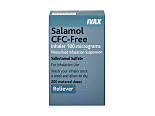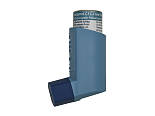Salbutamol Inhaler
Salbutamol is the standard blue reliever inhaler that can reduce the symptoms of asthma.
(16)







Prices from £12.00
In stock. Simply fill in a brief questionnaire. One of our doctors will review your order and prescribe a suitable treatment. How to Order
-
The salbutamol inhaler is a reliever inhaler used to reduce symptoms of asthma, such as wheezing, coughing, and feeling breathless. The active ingredient (salbutamol sulfate) works by relaxing the muscles of the airways into the lungs. This makes it easier to breathe. The usual way to use this inhaler is by taking 1 or 2 puffs as and when you need it.




About salbutamol inhalers
-
-
You can buy salbutamol online from trusted and regulated services that can provide prescriptions and treatments, such as Asda Online Doctor. To get salbutamol online from us, complete a short questionnaire about your asthma symptoms and health. One of our doctors will check that salbutamol is suitable for you and if so, they’ll issue a prescription. Your salbutamol inhaler will then be available at your chosen Asda Pharmacy for collection or sent via express delivery to your address.
-
-
Salbutamol is a form of medicine called a bronchodilator. Salbutamol inhalers are often referred to as a blue inhaler or a reliever inhaler. This is because they are normally blue in colour and they relieve symptoms of asthma when they happen. It is not used to prevent symptoms from happening in the first place.
Salbutamol itself is a generic (non-branded medication), but there are branded inhalers that you can get too. Salamol and Ventolin can both be used to relieve asthma symptoms and contain the same active ingredient.
-
-
You should only use your salbutamol inhaler when you need it, taking 1 or 2 puffs at a time. You should only use the inhaler 4 times in 24 hours. If you need more than this dose to give relief, you must speak to your doctor first.
Before using your salbutamol inhaler for the first time, you will need to check that it is working correctly.
- Remove the mouthpiece cover by squeezing the sides gently with your forefinger and thumb.
- Shake well, pointing the mouthpiece away from you, and press the canister to release two puffs into the air. If you have not used the inhaler in several days, you must shake well before use and release two puffs of medicine.
Once you are ready to use your salbutamol inhaler, the following steps will ensure you are using the inhaler correctly:
- Stand or sit upright before using the inhaler.
- Take off the mouthpiece cover and check the inside and outside to ensure the mouthpiece is clean.
- Shake the inhaler several times. This will make sure any loose objects are gone and the contents of the inhaler are evenly mixed.
- Hold the inhaler upright. Do this by placing your thumb on the base, below the mouthpiece. Breathe out as far as you comfortably can. You must not breathe in again yet.
- Place the mouthpiece in your mouth and be careful not to bite. Close your lips around the mouthpiece.
- Breathe in through your mouth. Once you start breathing in, hold down the top of the canister. This will release a puff of medicine. You should do this while still breathing in deeply and steadily.
- Take the inhaler from your mouth and your finger from the top of the inhaler, while holding your breath. Continue to hold your breath for several seconds, or as long as comfortably possible.
- If you have been advised by your doctor to take two puffs, you should wait for 30 seconds before taking another puff.
- Once finished, immediately replace the mouthpiece cover to prevent dust from entering.
At first, you may have trouble getting used to your salbutamol inhaler. To quickly adjust to the inhaler, you should practice in front of a mirror, to begin with. If you notice a ‘mist’ coming from the top of the inhaler, you should follow the instructions again.
If you or your child is still having difficulty using a salbutamol inhaler, you may benefit from a spacer. This is a device that helps you inhale the medication easier and inhale the whole dose correctly.
If you are pregnant, breastfeeding, or planning to have a baby, it is advised to speak to your doctor first before using salbutamol inhalers.
-
-
The salbutamol inhaler relaxes the muscles in the airways of the lungs, helping to open them up and making it easier to breathe. While most adults and children can use salbutamol inhalers, it may not be suitable for those with some medical conditions.
You should let your doctor know if you have:
- high blood pressure
- heart problems, such as an irregular heartbeat
- overactive thyroid
- had an allergic reaction to salbutamol sulfate in the past
-
-
Some people may get side effects from using a salbutamol inhaler, but not everyone will get them.
Common side effects include:
- your heart beating faster (without chest pain)
- headaches
- tremors (feeling shaky)
Uncommon side effects include:
- muscle cramps
- throat or mouth irritation
In rare instances, salbutamol inhalers can have very serious side effects, like:
- an allergic reaction
- severe headache that will not go away
- fast heartbeat with chest pain
- muscle pain or weakness
If you get rare side effects from using a salbutamol inhaler, you should seek medical help right away.
Medicines that may interact with salbutamol include:
- high blood pressure tablets, like beta blockers
- medicine used to treat heart disease
- water tablets (diuretics)
- medicine used to treat depression
-
-
Salbutamol belongs to a class of medications called bronchodilators. Bronchodilators work by opening and relaxing air passages to the lungs. This makes it easier to breathe.
Bronchodilators can be either:
- short acting (used as short term for relief from sudden asthma symptoms)
- long acting (used often to control symptoms of asthma)
You generally take this medicine to relieve symptoms when they happen. To prevent them from happening you will need to use either a preventer inhaler or a combination inhaler. A preventer inhaler is used every day to prevent symptoms from happening as often. They contain a type of medication known as a corticosteroid and are often brown in colour. Combination inhalers contain both types of medication, so they can be used to both stop and prevent symptoms. They are usually purple, or red and white in colour.
Other treatments like surgery or injections are rarely needed but may be advised if other treatments are not helping with asthma symptoms. There are also complementary therapies that have been suggested as potential treatments for asthma symptoms, like acupuncture and dietary supplements, but there has been little evidence to suggest these treatments help.

Dr Kathryn Basford is a qualified GP who works as a GP in London, as well as with ZAVA. She graduated from the University of Manchester and completed her GP training through Whipps Cross Hospital in London.
Meet our doctorsArticle created: 16 Sept 2021
Last reviewed: 16 Sept 2021
-
Bronchodilators (April 2019) NHS (Accessed 25 August 2021)
-
Salamol Easi-breathe CFC-Free Inhaler – Patient Information Leaflet (PIL) (June 2020) EMC (Accessed 25 August 2021)
-
Salbutamol inhaler dosage and other salbutamol info (June 2020) Patient.info (Accessed 25 August 2021)
-
Salbutamol: inhaler to relieve asthma and breathlessness (October 2018) NHS (Accessed 25 August 2021)
-
Ventolin Evohaler 100 micrograms – Patient Information Leaflet (PIL) (August 2021) EMC (Accessed 25 August 2021)
(Reviews are for ZAVA UK)


GMC: 7074021

GMC: 6149061

GMC: 7085115


Asda Online Doctor by ZAVA offers reliever inhalers to help manage asthma and for effective relief from symptoms.





